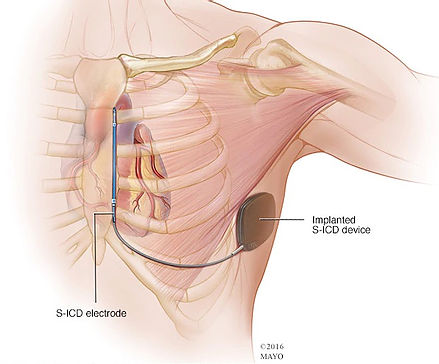What is an Implantable Cardioverter Defibrillator?
An implantable cardioverter defibrillator (ICD) is an electronic device that constantly monitors your heart rhythm. When it detects a very fast heartbeat (ventricular tachycardia), abnormal heart rhythm (arrhythmia), or a chaotic heartbeat that keeps your heart from supplying enough blood to the rest of your body (ventricular fibrillation), the ICD delivers energy to the heart muscle. This causes the heart to beat in a normal rhythm again.
ICD reduces the risk of dying if the lower chambers of your heart (ventricles) go into a dangerous rhythm and stop beating effectively (cardiac arrest).
Who needs an Implantable Cardioverter Defibrillator?
Ventricular tachycardia (very fast heartbeat) and ventricular fibrillation (chaotic heartbeat) are two life-threatening heart rhythms. These conditions can be fatal if not treated properly.
Your doctor may recommend an ICD if you’ve had at least one episode of these heart rhythms or are at high risk of developing these types of heart rhythms.
You’re a candidate for an ICD if you’ve had sustained ventricular tachycardia, survived a cardiac arrest, or fainted from a ventricular arrhythmia. You might also benefit from an ICD if you have:
- A history of coronary artery disease and heart attack that has weakened your heart.
- A heart condition that involves abnormal heart muscle, such as enlarged (dilated cardiomyopathy) or thickened (hypertrophic cardiomyopathy) heart muscle.
- An inherited heart defect that makes your heart beat abnormally. These include long QT syndrome, which can cause ventricular fibrillation and death even in young people with no signs or symptoms of heart problems.
- Having other rare conditions such as Brugada syndrome and arrhythmogenic right ventricular dysplasia also may mean you need an ICD.
Description of an Implantable Cardioverter Defibrillator
When you have a rapid heartbeat, the wires from your heart to the device transmit signals to the ICD, which sends electrical pulses to regulate your heartbeat. Depending on the problem with your heartbeat, your ICD could be programmed for the following therapies:
- Low-energy pacing therapy: You may feel nothing or a painless fluttering in your chest when your ICD responds to mild disruptions in your heartbeat.
- Cardioversion therapy: A higher energy shock is delivered for a more serious heart rhythm problem. It may feel as if you’re being thumped in the chest.
- Defibrillation therapy: This is the strongest form of electrical therapy used to restore a normal heartbeat. During this therapy, it may feel as if you’re being kicked in the chest, and it might even knock you off your feet.
The pain from this therapy usually lasts only a second. There should be no discomfort after the shock ends.
Usually, only one shock is needed to restore a normal heartbeat. Sometimes, however, you might have two or more shocks during a 24-hour period. Frequent shocks in a short time period are known as ICD storms. If you have ICD storms, you should seek emergency care to see if your ICD is working properly or if you have a problem that’s making your heart beat abnormally.
If necessary, the ICD can be adjusted to reduce the number and frequency of shocks. You may need additional medications to make your heart beat regularly and decrease the chance of an ICD storm.
An ICD can also be programmed to perform other functions, which include:
- Antitachycardia: If you have an unusually fast heart rate, the ICD delivers painless, low-energy impulses that pace or stimulate the heart to beat normally. This can prevent the need for cardioversion or defibrillation.
- Pacemaker: Most modern ICDs can also function as a pacemaker, delivering low-energy impulses that stimulate the heart to beat normally.
- Recording heart activity: The ICD records information about variations in your heart’s electrical activity and rhythm. This information helps your doctor evaluate your heart rhythm problem and, if necessary, reprogram your ICD.
Types of ICDs:
- Single Chamber
- Dual Chamber
- Biventricular Device

